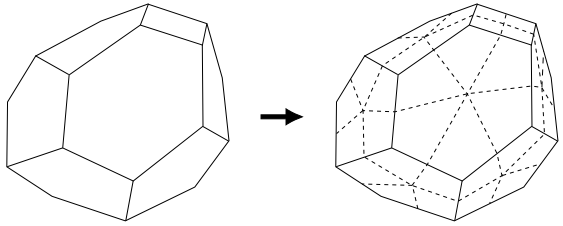The polyhedral unstructured mesh adaption (PUMA) method is only available for 3D meshes, and is selected by default. This method generalizes the adaption technique to meshes containing arbitrary polyhedra. Since it does not rely on templates for refinement, it is not limited to particular cell types and can refine any 3D type (polyhedra, tetrahedra, hexahedra, and so on). It also consumes less memory during mesh refinement when compared to the hanging node method.
A mesh can be coarsened after it has been refined, such that the child cells are agglomerated to reclaim the previously subdivided parent cell. A parent cell can only be reclaimed if all its children are marked for coarsening. You can eventually reclaim the original mesh with repeated application of the coarsening. Through this process, it is not possible to coarsen the mesh further than the original mesh.
The PUMA method has the following limitations:
It is only available for 3D cases.
Non-convex polyhedra are not guaranteed to be refined; they will be skipped if it is not possible to yield child cells that have a positive volume and an acceptable orthogonal quality.
The adapted mesh is very likely to include polyhedral cells, which are incompatible with remeshing methods.
The writing of adaption hierarchy and refinement history to file is not supported if you choose to write your case file in the legacy format (as described in Reading and Writing Files in the Legacy Format in the Fluent User's Guide). For this format, the hierarchy information is lost when a mesh adapted using this method is written to a case file, and so there are limitations if the mesh is read into a new session of Ansys Fluent: coarsening is not possible, and further refinement would produce different results than if it was performed in the original session.
The PUMA method cannot be applied to meshes that have a mesh hierarchy (for example, hexcore-type meshes). You may be able to remove the mesh hierarchy by converting the mesh to polyhedra using the
mesh/polyhedra/convert-hanging-nodestext command, or (for cases that have undergone hanging node adaption) by coarsening back to the original mesh.Legacy anisotropic or prismatic refinement is not supported for meshes that have undergone adaption with the PUMA method.
Fusing of face zones is only supported for serial cases.



